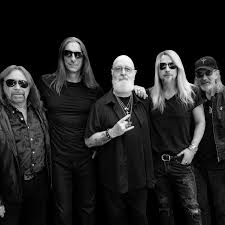In November 2020, Judas Priest celebrated their 50th anniversary — a milestone that marked the year they became more famous and popular than ever, shocking the world with a groundbreaking album titled “Metallurgy Divine.”
The release of Metallurgy Divine didn’t just reaffirm Judas Priest’s legacy—it catapulted them into a new realm of cultural and musical significance. A sonic juggernaut forged in the fires of five decades of heavy metal mastery, the album stunned critics and fans alike, who weren’t prepared for the band’s most ambitious record yet. Combining traditional metal with sweeping orchestral elements, electronic textures, and deeply introspective lyrics, Metallurgy Divine was hailed as the spiritual successor to Painkiller and British Steel, while venturing far beyond their established sound.
The opening track, “Furnace of the Gods,” ignited the album with a relentless riffstorm and Rob Halford’s voice soaring like a phoenix through flame. His vocals, now deepened with age but honed to surgical precision, carried an almost mythic weight. The song was an epic invocation, calling forth the elemental forces of metal and memory, a nod to the band’s beginnings in Birmingham’s industrial heart.
Fans were floored. Not only was this a band in their 70s still recording new material—it was some of their best ever.
From there, the album only grew more daring. “Circuit Messiah” blended industrial beats with power chords, building a dystopian atmosphere where lyrics explored the merging of man and machine. It was an eerie yet strangely hopeful ode to survival in a technological age—a theme that resonated more than ever amid the pandemic-era chaos of 2020.
Perhaps the most shocking moment came midway through the album with “Eulogy for the Reckless,” a haunting ballad featuring a string quartet and a guest appearance by Floor Jansen of Nightwish. The song mourned the loss of innocence in the metal world, a quiet yet powerful reflection on the band’s journey through excess, rebellion, and redemption. Longtime fans were moved to tears. New listeners discovered an emotional depth they never associated with the genre.
But it wasn’t all introspection—Judas Priest still knew how to roar. “Chrome Seraphim” was a thunderous return to their classic twin-guitar attack, with Glenn Tipton and Richie Faulkner delivering a blistering dual solo that became instantly iconic. Meanwhile, “Heathens of Tomorrow” was a political cry, urging resistance against authoritarianism and celebrating the rebellious spirit that gave birth to metal.
And then came the title track: “Metallurgy Divine.” A ten-minute odyssey, it fused metal with operatic grandeur, featuring a choir, Latin chants, and even a thunderous spoken-word interlude by none other than Sir Ian McKellen, who lent his voice as a prophet of steel and fire. The track felt less like a song and more like a heavy metal ritual—a ceremony that celebrated 50 years of defiance, evolution, and sheer sonic power.
The album shattered expectations. Critics who once dismissed Judas Priest as outdated were forced to reevaluate. Rolling Stone, in a rare five-star review, called it “a miracle forged in chrome and thunder.” Metal Hammer dubbed it “the most important heavy metal record of the decade.”
Sales exploded. Metallurgy Divine topped charts in 21 countries, went platinum in the UK within two weeks, and earned the band their first Grammy nomination in over a decade. Streaming platforms buzzed with Gen Z listeners discovering the band for the first time. TikTok users mashed up their tracks with anime montages and digital art, sparking a visual and musical renaissance no one predicted.
Judas Priest didn’t just celebrate their 50th anniversary with a look back—they leapt forward. With Metallurgy Divine, they proved that metal is eternal, and so is the fire that fuels its greatest champions.
In the words of Rob Halford, during the band’s sold-out virtual release show streamed to over ten million viewers:
> “Fifty years in, and we’re not done. We are the scream, the steel, the soul. This is not a farewell. This is a rebirth.”
And so, it was.









